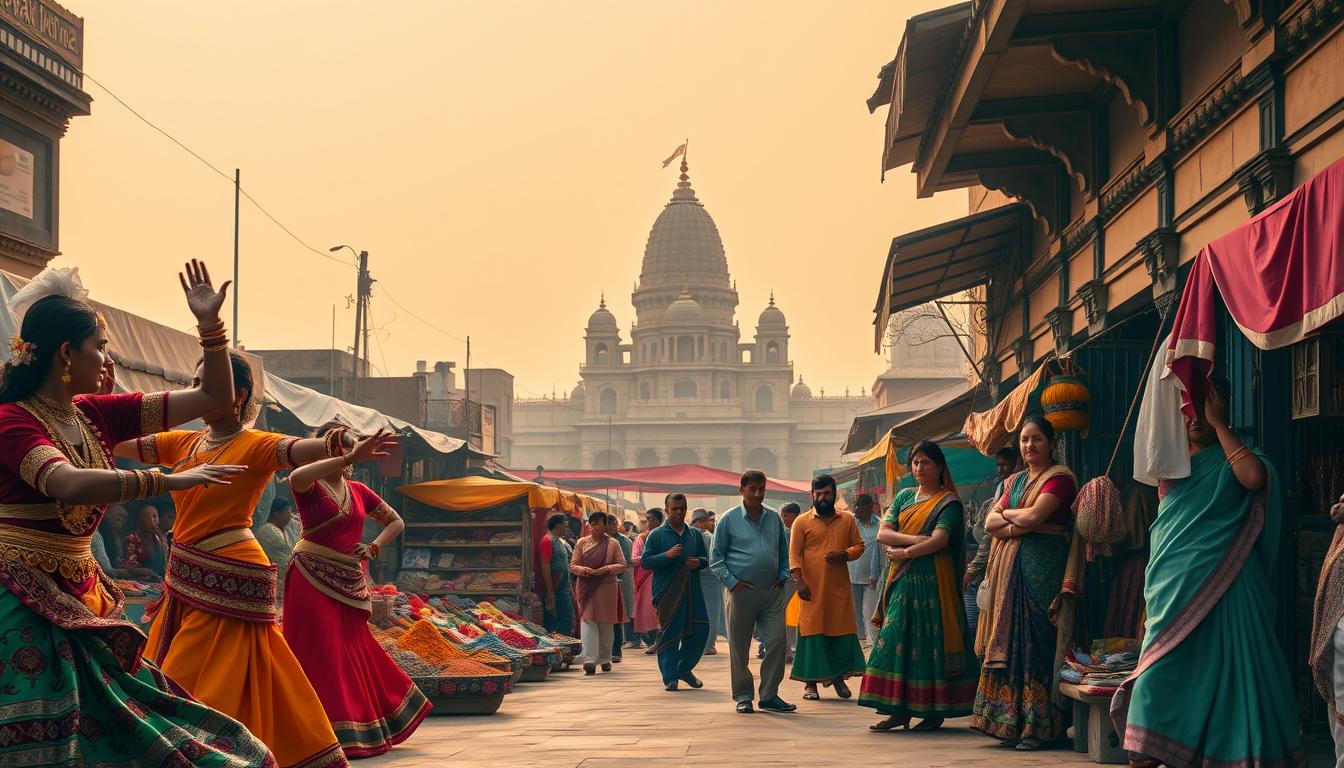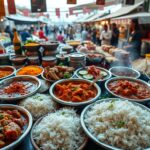The cultural heritage of India is a rich tapestry woven with diverse threads of vibrant traditions, languages, and customs.
From the snow-capped Himalayas to the sun-kissed beaches of the south, India’s indian culture is a unique blend of the old and the new.
This diversity is reflected in the numerous festivals, art forms, and rituals that are an integral part of indian traditions.
Key Takeaways
- India’s cultural heritage is diverse and rich.
- Vibrant traditions and customs are an integral part of indian culture.
- The country’s cultural landscape is shaped by its history and geography.
- Indian traditions are reflected in its numerous festivals and art forms.
- The blend of old and new is a unique aspect of indian culture.
The Colorful Mosaic of India’s Heritage
Indian culture is a rich tapestry woven from the threads of ancient traditions and modern expressions.
The legacy of ancient India continues to influence its modern culture. The Indus Valley Civilization, one of the earliest known cultures, has left a lasting impact on Indian society.
Today, Indian culture continues to evolve, incorporating modern elements while retaining its traditional essence. The blend of traditional and modern elements is evident in the country’s art, literature, music, and dance.
Understanding Indian Culture and Tradition
The essence of Indian culture lies in its deep-rooted values and philosophical underpinnings. Indian society has been shaped by a myriad of cultural, religious, and philosophical influences that have evolved over millennia.
Core Values and Philosophical Foundations
Indian culture is founded on strong core values such as respect for elders, the importance of family, and a deep sense of spirituality. The philosophical foundations of Indian culture are rooted in ancient texts like the Vedas and the Upanishads, which have guided the way of life for millions.
“The purpose of life is to inquire into the Truth, to learn to love and to share that love outwards.” – Ramana Maharshi
These values and philosophies have not only shaped individual lives but have also influenced the broader societal norms and practices.
The Caste System: Past and Present
The caste system has been a significant aspect of Indian society for centuries, influencing social hierarchy and occupational roles. Historically, it was a rigid system that determined one’s social status and profession based on birth.
| Caste | Traditional Occupation | Modern Implications |
|---|---|---|
| Brahmins | Priests and Teachers | High social status, often in education and government |
| Kshatriyas | Warriors and Rulers | Influential in politics and defense |
| Vaishyas | Traders and Merchants | Prominent in business and commerce |
| Shudras | Labourers | Often in service industries |
Cultural Evolution in Modern Times
Indian culture is not static; it continues to evolve with the influence of modernization and globalization. Today, Indian society is a blend of traditional values and modern aspirations.

The younger generation is at the forefront of this cultural evolution, embracing new ideas while still respecting traditional practices. This blend is evident in various aspects of Indian life, from education to entertainment.
Spiritual Tapestry: Religious Practices
India’s spiritual heritage is marked by the presence of several major world religions, creating a diverse and vibrant tapestry of religious practices. This diversity is not just a characteristic of Indian society; it is a defining feature that has shaped the country’s culture, traditions, and way of life.
Diverse Practices of Hinduism
Hinduism, the oldest and largest religion in India, encompasses a wide range of practices and beliefs. From the sacred rituals performed in temples to the personal devotional practices in homes, Hinduism is characterized by its diversity. The religion is known for its numerous deities and deesses, each representing different aspects of the divine. The epic tales of the Ramayana and Mahabharata are integral to Hindu mythology and continue to influence contemporary culture.

Buddhism, Jainism, and Sikhism
Alongside Hinduism, other significant religions in India are Buddhism, Jainism, and Sikhism. Buddhism, founded by Gautama Buddha, emphasizes the path to enlightenment through the Four Noble Truths. Jainism, with its core principle of non-violence, advocates for a path of spiritual purification. Sikhism, founded by Guru Nanak, emphasizes devotion to one God and the importance of community service. Each of these religions has contributed to the rich spiritual landscape of India.
Religious Harmony and Coexistence
One of the remarkable aspects of India’s religious diversity is the harmony and coexistence among different religious communities. Despite historical conflicts, the majority of Indians practice tolerance and respect for other faiths. This harmony is reflected in the numerous festivals and rituals celebrated across different religious communities, often with participation from others. The spirit of coexistence is a testament to India’s pluralistic society.
Festivals That Illuminate Indian Life
Indian life is illuminated by a myriad of festivals that bring people together in joy and celebration. These festivals are not just occasions for merriment but are deeply rooted in the country’s rich cultural heritage and spiritual traditions.
Diwali: The Festival of Lights
Diwali, one of the most significant festivals in India, is celebrated with great enthusiasm across the nation. It symbolizes the victory of light over darkness and good over evil. Homes are lit up with diyas and decorative lights, and families come together to exchange gifts and sweets.
Holi: The Celebration of Colors
Holi, the festival of colors, is a vibrant celebration that marks the arrival of spring. It is a day when people come together, forgetting their differences, and playfully drench each other in colored powders and waters. Holi is not just a celebration of colors but also a symbol of the triumph of good over evil.
Regional Festivals and Their Significance
India’s diverse regions celebrate their unique festivals, reflecting the country’s rich cultural tapestry.
North Indian Celebrations
North India is known for its grand celebrations of festivals like Lohri and Navratri. Lohri marks the beginning of the harvest season, while Navratri is a nine-day celebration dedicated to the worship of Goddess Durga, accompanied by traditional dances like Garba and Dandiya Raas.
South Indian Festivities
South India celebrates festivals like Pongal and Onam with great fervor. Pongal is a harvest festival that thanks the Sun God for the bounty of the land, while Onam is a ten-day celebration marking the homecoming of King Mahabali, characterized by traditional dances, flower decorations, and feasting.
Eastern and Western Regional Traditions
Eastern India is known for its Durga Puja celebrations, a grand festival honoring Goddess Durga. Western India, particularly Gujarat, celebrates Navratri with great enthusiasm, while Maharashtra observes Ganesh Chaturthi, a festival dedicated to Lord Ganesha.
These regional festivals not only add to the richness of Indian culture but also bring communities together, fostering a sense of unity and shared heritage.
Key Highlights:
- Diwali and Holi are among the most widely celebrated festivals in India.
- Regional festivals like Lohri, Pongal, and Onam reflect the diverse cultural heritage of different regions.
- These festivals are not just celebrations but are deeply rooted in spiritual and cultural traditions.
Culinary Journey Through India
Embarking on a culinary journey through India is like exploring a vibrant mosaic of tastes, where every region has its own distinct flavor profile. Indian cuisine is renowned for its diversity, reflecting the country’s rich cultural heritage.
Regional Flavors and Specialties
India’s culinary landscape is characterized by its regional specialties, shaped by local ingredients, climate, and cultural traditions. The contrast between North and South Indian cuisine is particularly noteworthy.
North vs. South Indian Cuisine
North Indian cuisine is known for its rich, creamy dishes like butter chicken and naan bread, influenced by Mughal and Persian cuisines. In contrast, South Indian cuisine is marked by its use of coconut, tamarind, and spices, with popular dishes including dosas and idlis.
Street Food Culture
Street food is an integral part of Indian cuisine, offering a wide range of snacks and quick bites. From spicy chaat items in the north to vada pav in the west, and idlis in the south, street food reflects the local flavors and preferences.
| Region | Popular Dishes | Key Ingredients |
|---|---|---|
| North India | Butter Chicken, Naan Bread | Yogurt, Garam Masala, Butter |
| South India | Dosa, Idli, Sambar | Coconut, Tamarind, Lentils |
| East India | Machhli Bhuna, Shukto | Fish, Mustard Oil, Bitter Gourd |
The Art of Indian Spices
Indian cuisine is famous for its use of spices, which are not just flavor enhancers but also carry medicinal properties. The art of blending spices is a crucial aspect of Indian cooking, with each region having its unique spice blends.
The use of Indian spices like turmeric, cumin, and coriander is widespread, contributing to the distinctive flavors of Indian dishes. The careful selection and blending of these spices are what make Indian cuisine so rich and diverse.
Artistic and Cultural Expressions
Artistic expressions in India are a testament to the country’s cultural diversity. India’s rich heritage is reflected in its various art forms, which have been passed down through generations.
Classical and Folk Dance Forms
Indian dance forms are a vibrant representation of its cultural richness. Classical dances like Bharatanatyam and Kathak are known for their grace and storytelling, while folk dances such as Bhangra and Garba are celebrated for their energetic performances.
- Bharatanatyam: A classical dance known for its intricate hand gestures and facial expressions.
- Bhangra: A lively folk dance from Punjab, characterized by energetic movements.
Music Traditions and Instruments
Indian music is characterized by its diverse traditions and instruments. Classical music in India is divided into two main categories: Hindustani (North Indian) and Carnatic (South Indian). Instruments like the sitar and tabla are integral to Indian music.
- Sitar: A stringed instrument used in Hindustani classical music.
- Tabla: A percussion instrument used in various Indian music genres.
Traditional Clothing and Textiles
Traditional clothing in India varies greatly across regions, reflecting the country’s diverse cultural heritage. Saris and lehengas are popular among women, while kurta-pyjamas and dhoti are worn by men.
Regional Dress Variations
Different regions in India have their unique traditional attire. For example, the south Indian saree is distinct from the Rajasthani lehengas.
Symbolism in Indian Attire
Indian clothing often carries symbolic meanings. For instance, the color red is associated with marriage and prosperity, while white is often worn during mourning.
Conclusion: The Enduring Legacy of Indian Culture
Indian culture is a vibrant mosaic of traditions, arts, and customs that have been passed down through generations. Its enduring legacy is a testament to the country’s rich heritage and its ability to adapt to changing times. The cultural heritage of India is a treasure trove of stories, music, and art that continue to inspire and enrich the lives of people around the world.
As we have explored, Indian culture is characterized by its diversity, from the classical arts to the regional traditions and customs. The significance of Indian culture lies not only in its historical importance but also in its continued relevance in modern times.
In conclusion, the enduring legacy of Indian culture is a reflection of its ability to evolve and adapt while retaining its unique identity.
FAQ
What is the significance of Indian culture and traditions?
Indian culture and traditions are significant because they reflect the country’s rich heritage and diversity, shaping the society and influencing the daily lives of its people.
How does Indian culture influence modern society?
Indian culture continues to evolve and influence modern society through its core values, philosophical foundations, and cultural practices, which are adapted and integrated into contemporary life.
What are the major religions practiced in India?
The major religions practiced in India are Hinduism, Buddhism, Jainism, and Sikhism, which coexist and contribute to the country’s religious harmony.
What is the significance of Diwali and Holi in Indian culture?
Diwali, the Festival of Lights, and Holi, the Celebration of Colors, are significant festivals in Indian culture, symbolizing the triumph of light over darkness and the arrival of spring, respectively.
How does Indian cuisine reflect the country’s cultural diversity?
Indian cuisine reflects the country’s cultural diversity through its regional flavors, specialties, and use of spices, which vary across different regions and communities.
What are the traditional clothing and textiles in India?
Traditional clothing and textiles in India include sarees, salwar kameez, and lehengas, which are often adorned with intricate designs and patterns, symbolizing the country’s rich cultural heritage.
How does Indian culture celebrate regional festivals?
Indian culture celebrates regional festivals with great enthusiasm, showcasing the unique traditions and cultural practices of different regions, such as North, South, East, and West India.
What is the role of classical and folk dance forms in Indian culture?
Classical and folk dance forms, such as Bharatanatyam and Kathak, play a significant role in Indian culture, expressing the country’s rich artistic heritage and storytelling traditions.
How does Indian culture promote religious harmony?
Indian culture promotes religious harmony through its tradition of tolerance and coexistence, allowing different religions to flourish and contribute to the country’s cultural richness.



